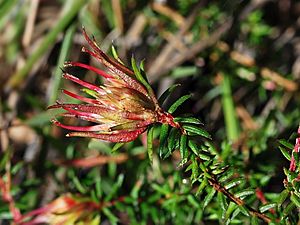Scarp darwinia facts for kids
Quick facts for kids Scarp darwinia |
|
|---|---|
 |
|
| Darwinia apiculata near Gosnells | |
| Conservation status | |
| Scientific classification | |
| Genus: |
Darwinia
|
| Species: |
apiculata
|
The scarp darwinia (scientific name: Darwinia apiculata) is a special plant that belongs to the myrtle family. It's only found in a small part of Western Australia. This plant is a small, round bush with lots of branches. It has thin red branches and small leaves spread out along them. Its flowers grow in small groups at the ends of the branches. The most striking part of the flowers are their long, red, pointed leaves called bracts that surround each flower. There's also a longer red part called a style that has tiny hairs near its tip.
Contents
What Does Scarp Darwinia Look Like?
The scarp darwinia is a bushy, round shrub that grows to be about 0.4 to 0.5 meters (about 1.3 to 1.6 feet) tall. It has many branches that are smooth and red. The bases of its leaves have small "wings" that go down the stems.
Leaves and Flowers
The leaves of the scarp darwinia are small, only about 3 to 7 millimeters (about 0.1 to 0.3 inches) long. They are thin and shaped like a triangle when you look at them from the side. The very tip of each leaf is sharply pointed.
The flowers grow in groups of 4 to 8 at the ends of the branches. These flower groups are surrounded by narrow, egg-shaped, pointed leaves called bracts, which can be up to 15 millimeters (about 0.6 inches) long. These bracts can be green, yellowish, or a mix of yellow and red. The flower petals are small, about 3 millimeters (0.1 inches) long. They cover the inner parts of the flower. The style, which is a long, thin part of the flower, is red and measures about 6 to 9 millimeters (0.2 to 0.4 inches) long. It has small hairs near its end.
Scarp darwinia usually flowers in October or November. After flowering, it rarely produces fruit, but when it does, it's a small nut with one or two seeds inside.
How Was Scarp Darwinia Named?
The scarp darwinia was first officially described in 1984 by a scientist named Neville Marchant. He published his description in a scientific journal called Nuytsia. The second part of its scientific name, apiculata, comes from a Latin word that means "small-pointed." This name refers to the plant's distinctly pointed leaves.
Where Does Scarp Darwinia Grow?
This special darwinia plant is only found in three small areas within the Darling Scarp in Western Australia. It grows in jarrah and marri woodlands. It prefers shallow, gravelly soil or sandy soil that sits on top of a hard rock layer called laterite, often near large granite rocks.
Scarp Darwinia's Life and Threats
When there's a bushfire, scarp darwinia plants are usually killed. However, new plants can grow from seeds that are stored safely in the soil. Scientists don't know exactly how this plant is pollinated, but other similar darwinia species are pollinated by insects or birds.
Some Darwinia plants can get a disease called dieback, caused by a fungus-like organism. But early tests suggest that the scarp darwinia might be resistant to this disease, which is good news!
What Threatens Scarp Darwinia?
The main dangers to the remaining scarp darwinia plants include:
- Too many fires: If fires happen too often, the plants don't have enough time to grow back from seeds.
- Road and firebreak work: Maintenance of roads and firebreaks can disturb the plant's habitat.
- Weed invasion: Weeds can grow and compete with the scarp darwinia for space and resources.
- Illegal dumping: People sometimes dump rubbish in its habitat.
- Mining: Mining activities can destroy the areas where it grows.
Protecting Scarp Darwinia
Because it's so rare and faces many threats, Darwinia apiculata is considered a "Threatened Flora" by the Western Australian Government's Department of Parks and Wildlife. They have even created a special plan to help it recover.
It's also listed as "Endangered" (EN) under the Australian Government's Environment Protection and Biodiversity Conservation Act 1999 (EPBC Act). This means it's in great danger because its populations are very spread out and the number of mature plants continues to decrease. Protecting this unique plant is very important!
Images for kids



